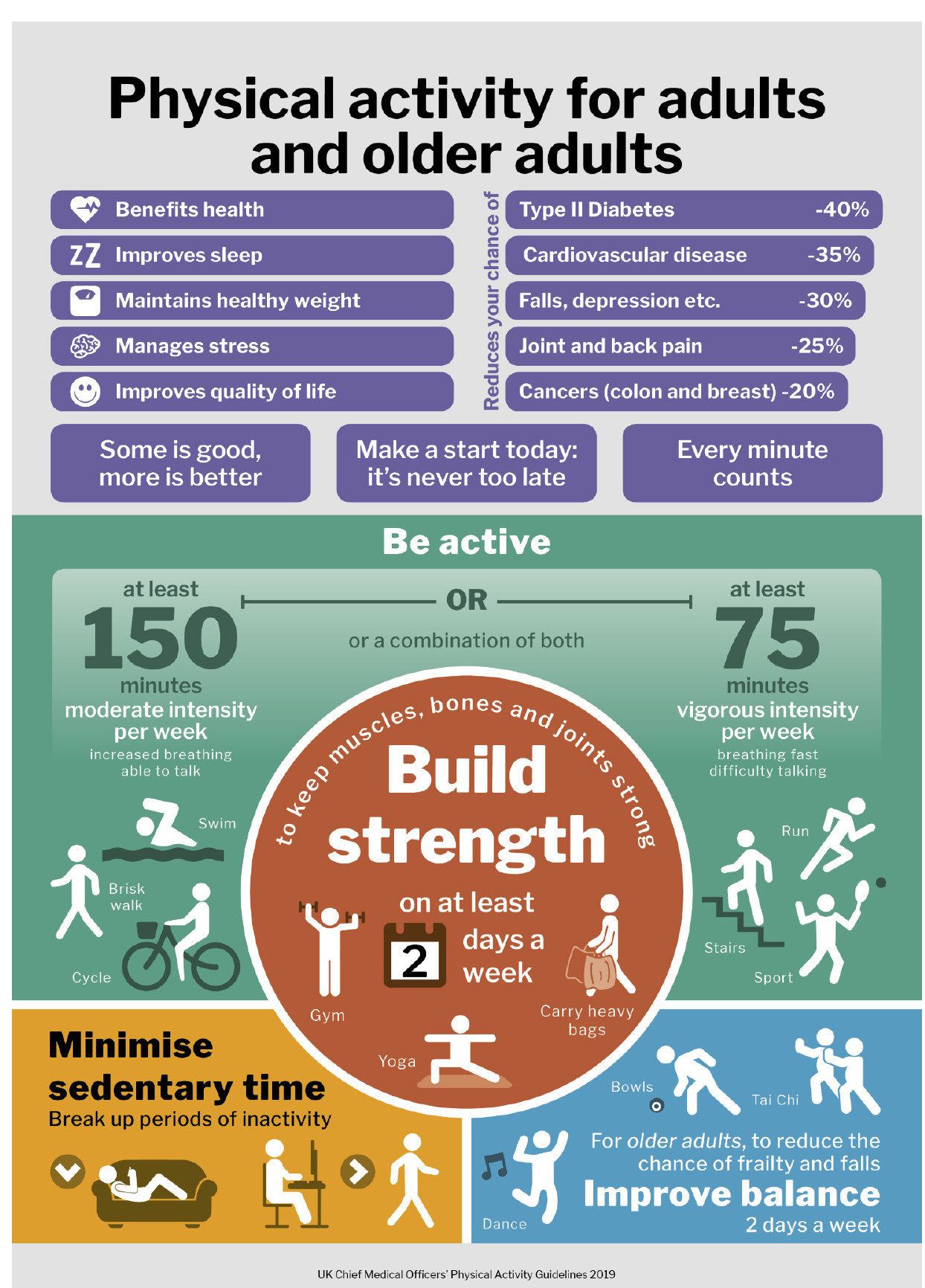Exercise and physical activity - brief advice for adults
The Chief Medical Officers' current recommendations for physical activity state that:
Adults (19 to 64 years)
- For good physical and mental health, adults should aim to be physically active every day. Any activity is better than none, and more is better still
- Adults should do activities to develop or maintain strength in the major muscle groups. These could include heavy gardening, carrying heavy shopping, or resistance exercise. Muscle strengthening activities should be done on at least two days a week, but any strengthening activity is better than none
- Each week, adults should accumulate at least 150 minutes (2 and 1/2 hours) of moderate intensity activity (such as brisk walking or cycling); or 75 minutes of vigorous intensity activity (such as running); or even shorter durations of very vigorous intensity activity (such as sprinting or stair climbing); or a combination of moderate, vigorous and very vigorous intensity activity
- Adults should aim to minimise the amount of time spent being sedentary, and when physically possible should break up long periods of inactivity with at least light physical activity
Older Adults (65 years and over)
- Older adults should participate in daily physical activity to gain health benefits, including maintenance of good physical and mental health, wellbeing, and social functioning. Some physical activity is better than none: even light activity brings some health benefits compared to being sedentary, while more daily physical activity provides greater health and social benefits
- Older adults should maintain or improve their physical function by undertaking activities aimed at improving or maintaining muscle strength, balance and flexibility on at least two days a week. These could be combined with sessions involving moderate aerobic activity or could be additional sessions aimed specifically at these components of fitness
- Each week older adults should aim to accumulate 150 minutes (two and a half hours) of moderate intensity aerobic activity, building up gradually from current levels. Those who are already regularly active can achieve these benefits through 75 minutes of vigorous intensity activity, or a combination of moderate and vigorous activity, to achieve greater benefits. Weight-bearing activities which create an impact through the body help to maintain bone health
- Older adults should break up prolonged periods of being sedentary with light activity when physically possible, or at least with standing, as this has distinct health benefits for older people.
* Moderate-intensity physical activity leads to faster breathing, increased heart rate and feeling warmer. Moderate-intensity physical activity could include walking at 3-4 mph, and household tasks such as vacuum cleaning or mowing the lawn (2)
**Vigorous-intensity physical activity leads to very hard breathing, shortness of breath, rapid heartbeat and should leave a person unable to maintain a conversation comfortably. Vigorous-intensity activity could include running at 6-8 mph, cycling at 12-14 mph or swimming slow crawl (50 yards per minute) (2)
Moderate and vigorous activity can be differentiated by the 'talk test': being able to talk but not sing indicates moderate intensity activity, while having difficulty talking without pausing is a sign of vigorous activity (1)

Reference:
- UK Chief Medical Officers' Physical Activity Guidelines (September 2019)
- NICE (May 2013).Physical activity: brief advice for adults in primary care
Related pages
Create an account to add page annotations
Annotations allow you to add information to this page that would be handy to have on hand during a consultation. E.g. a website or number. This information will always show when you visit this page.